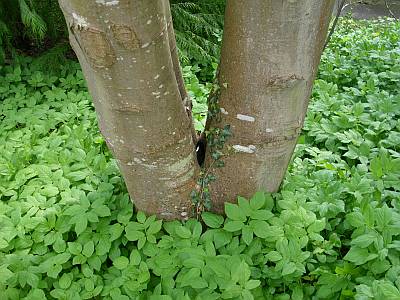In the intricate world of trees, every branch, leaf, and root tells a story. But there’s one part of a tree that often goes unnoticed despite its importance: the tree crotch. For property owners, understanding this tree feature is vital, both for safety and for the tree’s overall health.
What is a Tree Crotch?
Tree crotches are pockets or joints where two branches or a branch and the trunk come together. It’s a point of connection and can vary in shape and strength. Crotches play a significant role in a tree’s structural integrity and health.

Types of Tree Crotches
Trees can exhibit various crotch formations, each with its unique characteristics and concerns:
- Trunk-branch crotch: This forms when a branch grows directly from the trunk, creating a pocket or joint where they meet.
- Co-dominant stems: Here, two or more tree trunks emerge from the same point, typically at the tree’s base. This formation can create a pronounced pocket, accumulating water or debris.
- Branch-branch crotches: This is where two branches merge, forming a joint or pocket at their intersection.
Shapes of Tree Crotches
The shape of a crotch can give insights into its strength and potential risks:
- “U” Shaped Crotch: These have a rounded appearance and are generally considered more robust and more stable.
- “Y” or “V” Shaped Crotch: These have a pointed or acute angle, which can be a potential weak point, significantly if the bark gets compressed into the crotch, preventing proper fusion of the branches or trunks.
Why Property Owners Should Be Cognizant of Tree Crotches
- Safety: A compromised crotch can become a breaking point. Especially in severe weather or under the weight of snow or ice, weak crotches can give way, leading to falling branches or trunks that can damage property or cause injury.
- Tree Longevity: Crotches, especially those that collect water or debris, can become sites for fungal infections or rot, compromising the tree’s health and reducing its lifespan.
- Landscaping Goals: For those keen on a specific aesthetic, the shape and structure of tree crotches can influence the tree’s overall appearance, growth direction, and balance.
- Economic Implications: Addressing a fallen branch or treating a diseased tree can be costly. By understanding and monitoring tree crotches, property owners can take preventative measures, potentially saving on future expenses.
- Conservation of Property Value: A well-maintained tree can enhance the property’s appeal and value. On the other hand, a tree showing signs of weakness, often stemming from crotch issues, might detract from the property’s worth.
Conclusion
Trees are silent witnesses to time, offering shade, beauty, and numerous environmental benefits. For property owners, understanding the nuances of tree anatomy, especially tree crotches, is pivotal. It’s not just about maintaining the tree; it’s about ensuring the safety, beauty, and value of the property they grace.